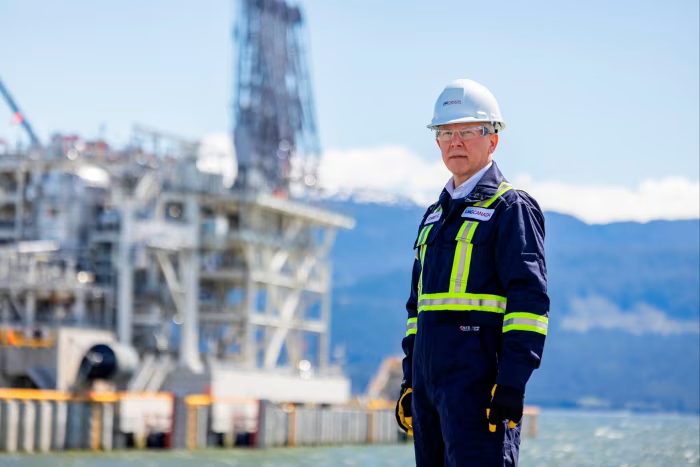KITIMAT (Realist English). Once dubbed “the town of tomorrow,” the remote community of Kitimat in British Columbia is again at the center of Canada’s industrial ambitions. This week, the multibillion-dollar LNG Canada terminal began shipping liquefied natural gas (LNG) to Asia, marking a milestone in Ottawa’s effort to reposition the country as an energy superpower.
Backed by Shell, Mitsubishi and other Asian firms, the C$40bn facility is the largest energy infrastructure project in Canadian history and the country’s first LNG terminal. For Kitimat, it signals a potential rebirth after decades of industrial decline. For Prime Minister Mark Carney, it’s a centerpiece in a broader strategy to boost energy exports, diversify trade routes beyond the US, and counterbalance rising geopolitical uncertainty.
“President Trump’s tariffs are disrupting trade and threatening Canadian jobs,” said Energy Minister Tim Hodgson, referencing the Biden-to-Trump policy shift in Washington. “Projects like LNG Canada are a cornerstone of our plan to secure long-term competitiveness while building the world’s most reliable low-carbon energy system.”
A delayed energy pivot
Despite abundant gas reserves, Canada has long struggled to build infrastructure to access global markets. Over 90% of oil and gas exports go to the US, often sold at a discount due to lack of international transport links. Decades of regulatory delays, environmental opposition, and infrastructure deficits have stymied efforts to build pipelines or LNG terminals.
That left the field open to the US, now the world’s top LNG exporter, which has rapidly expanded its Gulf Coast terminals. Canada, meanwhile, saw over a dozen LNG projects canceled in the past 15 years. Only LNG Canada, plus two smaller projects — Woodfibre LNG and Cedar LNG — are currently under construction.
According to Masaru Saito of Mitsubishi, the Canadian opportunity remains immense: “We believe Canada can become a major player in the global energy landscape. The resource base and capacity are there.”
Still, the route to that future is complex. Construction of the Coastal GasLink pipeline — the lifeline to the LNG Canada terminal — faced opposition from First Nations, cost overruns, and protests, eventually doubling in cost to C$14.5bn. Indigenous leaders like Chief Na’moks of the Wet’suwet’en Nation continue to warn of environmental and democratic erosion: “We will not support the destruction of our lands or our rights.”
Competing visions, competing pressures
Carney’s government recently passed legislation to fast-track environmental reviews for “national interest” energy projects, hoping to compress approval timelines to two years. But indigenous groups say it undermines their legal right to meaningful consultation.
At the same time, Canada’s energy sector sees the need for urgency. A proposed emissions cap introduced under Trudeau-era climate policies remains in place, even as Carney has scrapped the controversial carbon tax. According to François Poirier, CEO of TC Energy, Canadian LNG can play a critical role in helping Asia reduce coal use — if regulatory burdens are eased.
“Canada can’t afford to delay any longer,” said Lisa Baiton, head of the Canadian Association of Petroleum Producers. “We’re facing $100bn in potential projects — but they need a clear path forward.”
Local partnerships as a new model
Some First Nations leaders are embracing development — under specific conditions. Last month, Enbridge sold a 12.5% stake in its Westcoast pipeline system to a consortium of 36 Indigenous communities, backed by a federal loan program. Meanwhile, the Haisla Nation is preparing to host Cedar LNG, a majority-indigenous-owned floating plant set to begin operations near Kitimat.
“Partnership is the key,” said Crystal Smith, chief councillor of the Haisla. “If Canada wants to be an energy superpower, First Nations must be in the driver’s seat.”
Strategic upside, competitive pressure
According to Wood Mackenzie, Canadian LNG has a cost advantage on shipments to Japan — especially due to Kitimat’s 10-day shipping time, compared to over 20 from the Gulf Coast. The facility is also powered by hydroelectricity, giving it one of the lowest carbon footprints in the global LNG market.
Still, global competition is fierce. Shell projects a 60% surge in LNG demand by 2040, driven by Asian markets seeking to reduce coal use. But for Canada to claim a significant share, it must overcome decades of inertia, resolve internal political divides, and win investor confidence.
For now, the flame flares over Kitimat’s skyline again — this time not as a symbol of decline, but of a nation testing its energy ambitions in a fractured world. Whether that ambition translates into lasting infrastructure, market power, and domestic consensus remains Canada’s next big test.


















